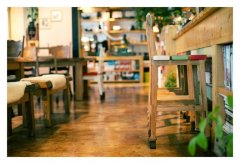How about coffee in Hasunda Manor, Ecuador? how many kinds of coffee beans in Hasunda Manor?

For professional baristas, please follow the coffee workshop (Wechat official account cafe_style)
How about coffee in Hasunda Manor, Ecuador? how many flavors of coffee beans in Hassanda Manor?
As the world coffee industry is moving towards a targeted mass production model, a small and uncertain coffee industry such as San Cristobal is in trouble and may eventually be forced to give up without profit.
In the early 1990s, however, the Gonzalez family bought Hasunda Coffee Park. The local microclimate caused by the Humboldt current (Humboldt Current), strong equatorial sunlight and sharp temperature changes (43 ℃ at sea level and 16 ℃ at 275m above sea level) provide a unique advantage, prompting the Gonzalez family to expand their coffee plantations.
Since then, the area of the coffee plantation has doubled through the reclamation of early land. Because of the unique role of the Galapagos Islands in the course of history, the Government of Ecuador has designated the Galapagos Islands as a national park and no longer allows the land to be reclaimed as new agricultural land. and the introduction and use of chemical fertilizers, pesticides, herbicides and other chemicals are strictly prohibited, so coffee in the Galapagos Islands is recognized as a natural product.
The Ecuadorian national flag is rectangular, with a ratio of length to width at 2:1. The flag is made up of three rectangles connected by yellow, blue and red. Yellow occupies 1 quarter of the flag, while red and blue each account for 4. The national emblem is painted in the central government. Yellow symbolizes the wealth, sunshine and food of the country; blue symbolizes the blue sky, the sea and the magnificent Amazon; and red symbolizes the blood of patriots fighting for freedom and justice. Ecuador has a presidential system. On 26 November 2006, Correa, a candidate of the Sovereign Motherland Movement, was elected president in the second round of presidential elections and took office on 15 January 2007. Immediately after taking office, Coe promoted the convening of the Constituent Assembly. On April 15, 2007, Eritrea decided to hold a Constituent Assembly in a referendum with an approval rate of 81.72%. In September, Eritrea held an election of representatives to the Constituent Assembly, and the ruling party, the Sovereign Motherland Union, won 61% of the seats. In July 2008, the Constituent Assembly adopted the new draft constitution. In September, the new constitution was passed in a referendum with 63.94% of the vote. In October, the new constitution was formally promulgated and implemented. In April 2009, Eritrea re-held presidential, parliamentary and local government elections in accordance with the new constitution, and Correa was re-elected president. On September 30, 2010, large-scale police protests broke out and riots broke out in major cities such as Quito, Ecuador, in protest against the adoption by the National Congress of the Public Service Act, which included provisions for cuts in police and military benefits. President Correa was attacked and was trapped for a time, then rescued with the support of the military, parliament and the international community. On May 7, 2011, Eritrea held a referendum on 10 political and social issues, including judicial reform and media control, all of which were adopted. Since 2012, the political situation in Eritrea has remained stable.
The Arabian Coffee Tree was first introduced to Ecuador (Ecuador) in 1952 and its coffee is of good quality, especially the coffee harvested in early June. Ecuadorian coffee beans can be divided into two varieties: Galapagos and Gigante, both of which have the characteristics of large granules and heavy weight. Ecuadorian coffee can be divided into first class (No.1) and super excellent (ExtraSuperior) according to its quality. They are mainly exported to the Nordic countries of Scandinavia. The main problem facing coffee producers is their efforts to maintain stable quality. The coffee here is generally well-balanced and refreshing, with a unique aroma. Ecuador is one of the few countries in South America that produces both Arabica coffee and Robbins coffee.
However, as the land suitable for Arabica coffee trees is decreasing, the production of Robbins coffee is gradually increasing. The best Arabica coffee comes from the Andes, especially the Chanchagu Valley (ChanchamgoValley), which is divided into two series of mountains that extend from south to north to the Galapagos Islands in central Ecuador, located in the Pacific Ocean, about a thousand kilometers off the coast of Ecuador. The archipelago consists of 13 major islands and small islands as well as reefs covering 8000 square kilometers and is one of the noblest national parks in the world. 97% of the territory belongs to Galapagos National Park, a protected area. The United Nations Educational, Scientific and Cultural Organization has declared this place a World Natural Heritage site.
These islands are volcanic landforms formed by magmatic eruptions. Even now, constant volcanic eruptions are shaping the geography of the archipelago. The Galapagos Islands are the products of one of the greatest volcanic activities in the world. The climate here is largely affected by ocean currents, including the Humboldt cold current and the El Ni ñ o warm current.
Galapagos is rich in species, warm and cold world of animals and plants, here is a natural paradise. The most famous animal is a prehistoric creature, the giant tortoise, also known as the Galapagos tortoise (one of the oldest animals in the world, which has lived here for millions of years.) Iguanas are the only lizards that live in the sea, as well as land lizards and Darwinian finches. Other animals are blue-footed boobies, frigate birds, albatrosses, the only penguins that live in hot water, cormorants, and sea lions.
As the local arable land is very limited, Galapagos coffee is very rare. Since Manuel J.Cobos first cultivated coffee here in the late 19th century, the coffee seeds here have never been hybridized or changed. Therefore, coffee on Galapagos Island is considered to be one of the purest Arabica coffee beans in the world. Galapagos coffee has excellent quality, grows in fertile volcanic soil, and is rich in minerals such as phosphorus. The cultivation of coffee is not affected by any chemicals. The Arabian coffee tree was first introduced to Ecuador (Ecuador) in 1952 and its coffee quality is very good, especially the coffee harvested in early June. Ecuadorian coffee beans can be divided into two varieties: Galapagos and Gigante, both of which have the characteristics of large granules and heavy weight. Ecuadorian coffee can be divided into first class (No.1) and super excellent (ExtraSuperior) according to its quality. They are mainly exported to the Nordic countries of Scandinavia.
Ecuador is one of the few countries in South America that produces both Arabica coffee and Robbins coffee. However, as the land suitable for Arabica coffee trees is decreasing, the production of Robbins coffee is gradually increasing. The best Arabica coffee comes from the Andes, especially the Chanchagu Valley (ChanchamgoValley), which is divided into two mountains, extending from south to north to central Ecuador.
The Galapagos Islands are located in the Pacific Ocean, about 1,000 kilometers off the coast of Ecuador. The archipelago consists of 13 major islands and small islands as well as reefs covering 8000 square kilometers and is one of the noblest national parks in the world. 97% of the territory belongs to Galapagos National Park, a protected area. The United Nations Educational, Scientific and Cultural Organization has declared this place a World Natural Heritage site.
These islands are volcanic landforms formed by magmatic eruptions. Even now, constant volcanic eruptions are shaping the geography of the archipelago. The Galapagos Islands are the products of one of the greatest volcanic activities in the world. The climate here is largely affected by ocean currents, including the Humboldt cold current and the El Ni ñ o warm current.
The main problem facing coffee producers is their efforts to maintain stable quality. The coffee here is generally well-balanced and refreshing, with a unique aroma.
Galapagos is rich in species, warm and cold world of animals and plants, here is a natural paradise. The most famous animal is a prehistoric creature, the giant tortoise, also known as the Galapagos tortoise (one of the oldest animals in the world, which has lived here for millions of years.) Iguanas are the only lizards that live in the sea, as well as land lizards and Darwinian finches. Other animals are blue-footed boobies, frigate birds, albatrosses, the only penguins that live in hot water, cormorants, and sea lions.
As the local arable land is very limited, Galapagos coffee is very rare. Since Manuel J.Cobos first cultivated coffee here in the late 19th century, the coffee seeds here have never been hybridized or changed. Therefore, coffee on Galapagos Island is considered to be one of the purest Arabica coffee beans in the world. Galapagos coffee has excellent quality, grows in fertile volcanic soil, and is rich in minerals such as phosphorus. The cultivation of coffee is not affected by any chemicals. Mount Chimborazo, located in the West Cordillera in the Andes, has long been mistaken for the highest peak in the Andes. It is a dormant volcano with many craters and glaciers at the top of the mountain, which is more than 4694 meters. Port Guayaquil is the largest seaport in Ecuador. It faces the Pacific Ocean and backs against Mount Santa Ana. The nearby island of Pune serves as a natural barrier to protect the harbour from storms.
There is a wharf in the south, which is more than 900 meters long. Ships from different parts of the world flying various flags are moored in the harbor. The port railway leads to the capital Quito, and highways connect Quito with other cities in the country. Bananas, cocoa, coffee, cotton and other products from all over the country are collected and distributed here. Guayaquil has also played an important role in the history of friendly exchanges between the peoples of China and Ecuador. As early as the 18th century, Chinese clothing, textiles and other goods were shipped to Ecuadorian cities through Guayaquil. In August 1978, the Chinese cargo ship Jialing River arrived here for the first time. Most of the import and export goods of the two countries are the Ecuadorian national emblem transshipped through Guayaquil. Ecuador's national emblem was launched in 1900, similar to the national emblem of Colombia. A ferocious "American Condor" vulture stands above the national emblem. It is the national bird of Ecuador, symbolizing sovereignty and independence. The design of Ecuador's national emblem is unique, which fully shows the amorous feelings of the country: the snow-capped Mount Chimborazo, Ecuador's highest peak, stands towering on the banks of the Pacific Ocean against the blue sky, with verdant trees at the foot of the mountain. a large river winds out from the depths of the mountains and gradually merges into the blue sea. The earliest steam ocean-going ship of South America, which Ecuadorians are proud of, is moored at sea.
Ecuador Ecuador
Population: 15224000
Ecuadorian coffee is increasingly prominent in the boutique coffee industry, and although low-lying areas are unlikely to produce good coffee, higher elevations have great potential.
GALAPAGOS
The Galapagos Islands GALAPAGOS produces a small amount of coffee in the Galapagos Islands, and its supporters claim that the climate there simulates higher elevations and can grow higher-quality coffee. Coffee like this can be very expensive and does not reflect the quality in price.
Altitude: 350m
Harvest: June-September and December February varieties: bourbon
Coffee treasures from the hometown of giant turtles, which are of excellent quality and do not use any chemicals when growing.
Coffee is grown in Saint Crst ó bal. St. Cristobal is a larger island in the Galapagos Islands (Galapagos Islands) and the only one in the archipelago with plenty of fresh water. At an altitude of 410m, there is a small lake called El.Junco, where several streams flow along the rocks and volcanic rocks on the southern slope of the island, and mineral-rich fresh water moistens the land of St. Cristobal, keeping the soil moist and fertile.
In 1875, the Ecuadorian native Ma Covos planted about 100 hectares of Arabian bourbon coffee trees at the Hasunda Coffee Garden (Hacienda El Cafetal) in San Cristobal. The elevation of the plantation is between 140m and 275m, and the climate in this area is equivalent to that of 910m to 1830 m inland. This gradient is suitable for the growth of high acidity extra hard coffee beans (SHB) and is the key to the high quality of coffee.
Important Notice :
前街咖啡 FrontStreet Coffee has moved to new addredd:
FrontStreet Coffee Address: 315,Donghua East Road,GuangZhou
Tel:020 38364473
- Prev

What are the characteristics of coffee beans in Hasunda Manor in Ecuador? how much is the coffee in Hasunda Manor?
Professional baristas exchange please pay attention to the coffee workshop (Wechat official account cafe_style) Ecuador Hasunda Chateau coffee beans what is the characteristics of Hasunda Manor coffee how much is the Ecuadorian flag is rectangular, the ratio of length to width at 2:1. The flag is made up of three rectangles connected by yellow, blue and red. Yellow occupies 1 quarter of the flag, while red and blue each account for 4. The national emblem is painted in the central government. Yellow symbolizes the wealth of a country
- Next

Ecuador Hasenda Manor coffee production area introduction Hasenda Manor coffee beans elevation
Professional barista exchange please pay attention to coffee workshop (Weixin Official Accounts cafe_style ) Ecuador Hasenda Manor coffee production area introduction Hasenda Manor coffee beans altitude harvest: June September and December February variety: Bourbon coffee treasures from the hometown of giant turtles, this coffee treasure, excellent quality, planting without the use of any chemicals. Coffee growing in San Cristobal
Related
- Does Rose Summer choose Blue, Green or Red? Detailed explanation of Rose Summer Coffee plots and Classification in Panamanian Jade Manor
- What is the difference between the origin, producing area, processing plant, cooperative and manor of coffee beans?
- How fine does the espresso powder fit? how to grind the espresso?
- Sca coffee roasting degree color card coffee roasting degree 8 roasting color values what do you mean?
- The practice of lattes: how to make lattes at home
- Introduction to Indonesian Fine Coffee beans-- Java Coffee producing area of Indonesian Arabica Coffee
- How much will the flavor of light and medium roasted rose summer be expressed? What baking level is rose summer suitable for?
- Introduction to the characteristics of washing, sun-drying or wet-planing coffee commonly used in Mantenin, Indonesia
- Price characteristics of Arabica Coffee Bean Starbucks introduction to Manning Coffee Bean Taste producing area Variety Manor
- What is the authentic Yega flavor? What are the flavor characteristics of the really excellent Yejasuffi coffee beans?

